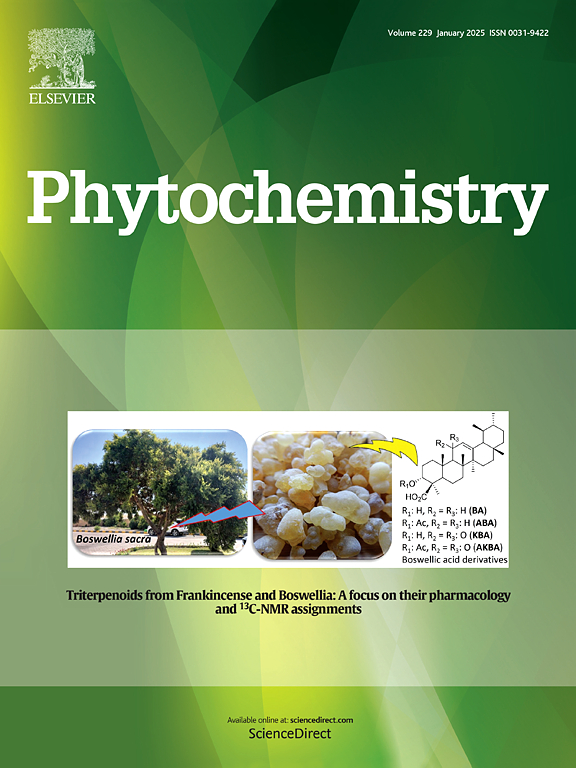大戟的倍半萜类化合物。
IF 3.4
2区 生物学
Q2 BIOCHEMISTRY & MOLECULAR BIOLOGY
引用次数: 0
摘要
六种未描述的倍半萜酯,拟酚A-F,以及十四种已知的多环烷类似物从生长在乌兹别克斯坦的大戟叶的空中部分分离出来。它们的结构是在广泛的光谱分析的基础上确定的,通过比较实验和计算的ECD数据确定了绝对构型,此外还有单晶x射线衍射晶体学。真酚A-F(1-6)为真酚A-D(1-4)的多环烷和真酚E-F(5-6)的芳香腺嘌呤。化合物7 ~ 20为首次从大戟属植物中分离得到,其中化合物7自然是史无前例的。生物活性实验表明,3种化合物(3、9和10)携带9-酮基团和三取代苯甲酰氧基部分的6-酰基残基,通过抑制lps诱导的RAW 264.7巨噬细胞NO的释放而具有抗炎作用,IC50值为22.49±0.21 ~ 30.31±1.19 μM。此外,含有Δ9、Δ8或8β-OH和6-苯甲酰氧基的5种酯(3、9、11、14和18)具有通用取代模式,对HeLa、HT-29和MCF-7细胞系具有一定的细胞毒性,化合物18的IC50值分别为14.71±0.75、15.30±0.75和26.36±1.84 μM。本文章由计算机程序翻译,如有差异,请以英文原文为准。

Sesquiterpenoids from Euphorbia esula L.
Six undescribed sesquiterpene esters, euphoresulins A–F, along with fourteen known daucane analogues were isolated from the aerial parts of Euphorbia esula growing in Uzbekistan. Their structures were determined on the basis of extensive spectroscopic analyses, with absolute configurations established by comparison of experimental and calculated ECD data, in addition to single-crystal X-ray diffraction crystallography. Euphoresulins A–F (1–6) presented sesquiterpene ester types of daucane for euphoresulins A–D (1–4) and aromadendrane for euphoresulins E–F (5–6). Compounds 7–20 were firstly isolated from the genus Euphorbia, wherein compound 7 was naturally unprecedented. Bioactivity assays revealed that three compounds (3, 9 and 10) carrying 9-keto group and 6-acyloxy residue of trisubstituted benzoyloxy moiety demonstrated anti-inflammatory effects by inhibiting the release of NO in LPS-induced RAW 264.7 macrophages, with IC50 values ranging from 22.49 ± 0.21 to 30.31 ± 1.19 μM. Additionally, five esters (3, 9, 11, 14 and 18) bearing Δ9, Δ8 or 8β-OH, and 6-benzoyloxy groups with versatile substitution patterns displayed certain cytotoxic activities against HeLa, HT-29 and MCF-7 cell lines, representing IC50 values of 14.71 ± 0.75, 15.30 ± 0.75 and 26.36 ± 1.84 μM, respectively for compound 18.
求助全文
通过发布文献求助,成功后即可免费获取论文全文。
去求助
来源期刊

Phytochemistry
生物-植物科学
CiteScore
6.40
自引率
7.90%
发文量
443
审稿时长
39 days
期刊介绍:
Phytochemistry is a leading international journal publishing studies of plant chemistry, biochemistry, molecular biology and genetics, structure and bioactivities of phytochemicals, including ''-omics'' and bioinformatics/computational biology approaches. Phytochemistry is a primary source for papers dealing with phytochemicals, especially reports concerning their biosynthesis, regulation, and biological properties both in planta and as bioactive principles. Articles are published online as soon as possible as Articles-in-Press and in 12 volumes per year. Occasional topic-focussed special issues are published composed of papers from invited authors.
 求助内容:
求助内容: 应助结果提醒方式:
应助结果提醒方式:


